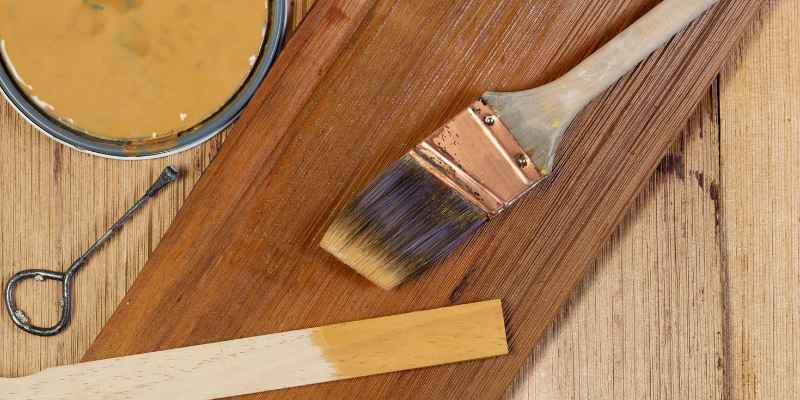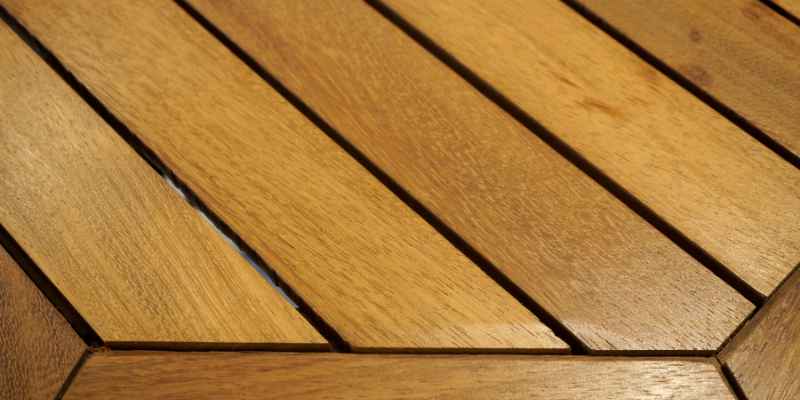Yes, you can stain teak wood to enhance its appearance and protect it from damage. Teak wood is a popular choice for outdoor furniture and decking due to its natural durability and resistance to rot, but staining it can help to maintain its color and prevent it from weathering over time.
Intro: Teak wood is known for its beauty and durability, making it a popular choice for furniture and outdoor structures. However, over time, teak wood can fade and lose its natural color due to exposure to the elements. Staining teak wood is an effective way to enhance its appearance and protect it from damage.
By applying a stain to teak wood, you can rejuvenate its color, increase its resistance to moisture, and extend its lifespan. We will explore the process of staining teak wood and provide some tips for achieving the best results. So, if you have a teak wood piece that needs a little makeover or if you want to protect your new teak furniture, read on to learn how to stain teak wood effectively.
Why Stain Teak Wood
Staining teak wood is an excellent way to enhance its beauty and protect it from the elements. While teak wood is known for its natural durability and resistance to rot and decay, staining can provide an extra layer of protection against sun, rain, and other outdoor elements. Additionally, staining teak wood can bring out its rich, warm hues and highlight the natural grains, adding beauty and elegance to your furniture or deck. Finally, by staining teak wood, you can preserve its longevity, ensuring that it lasts for many years to come.
Protection From Elements
Staining teak wood offers essential protection against the harsh outdoor elements. While teak wood is naturally resistant to rot and decay, exposure to sun, rain, and fluctuating temperatures can cause it to fade and lose its hue over time. By applying a stain specifically designed for teak wood, you create a barrier that shields it from UV rays, moisture, and other damaging factors. This protection helps to maintain the wood’s integrity and preserves its natural beauty for longer periods.
Enhance Natural Beauty
Staining teak wood enhances its natural beauty, bringing out the rich, warm tones and highlighting the unique grain patterns. Teak wood is already known for its attractive appearance, but adding a stain can further intensify its visual appeal. Whether you choose a transparent stain to accentuate the wood’s natural colors or opt for a darker shade to create a more dramatic effect, staining teak wood can transform an ordinary piece of furniture or outdoor space into a stunning focal point.
Preserve Longevity
By staining teak wood, you can extend its lifespan and ensure that it remains in excellent condition for years to come. The stain acts as a protective layer, safeguarding the wood from daily wear and tear, such as scratches, spills, and fading caused by sun exposure. This preservation of the wood’s integrity not only helps maintain its aesthetic appeal but also ensures that your teak furniture or deck withstands the test of time, making it a valuable investment in the long run.
Overall, staining teak wood offers numerous benefits, including protection from the elements, enhancing its natural beauty, and preserving its longevity. Whether you have teak furniture or a teak deck, applying a suitable stain will not only enhance its appearance but also prolong its lifespan, allowing you to enjoy its beauty for many years.

Choosing The Right Stain
When it comes to staining teak wood, choosing the right stain is critical to achieving the desired look and protecting the wood’s natural beauty. There are several factors to consider, including the transparency of the stain, whether it is oil-based or water-based, and how well it matches the color of the teak wood.
Transparent Vs. Opaque Stains
One of the first decisions you need to make when selecting a stain for teak wood is whether you prefer a transparent or opaque finish. Transparent stains allow the natural grain and color of the wood to show through, enhancing the rich beauty of teak. This is an excellent choice if you want to highlight the wood’s natural appearance.
On the other hand, opaque stains offer more coverage, concealing imperfections and providing a more uniform color. While they still allow the texture of the wood to be seen, they create a more solid and consistent appearance. Opt for an opaque stain if you want to change or mask the original color of the teak wood.
Oil-based Vs. Water-based Stains
Another important consideration is whether to use an oil-based or water-based stain. Oil-based stains are known for their durability and ability to penetrate deep into the wood, providing long-lasting protection. They offer a rich and natural finish, bringing out the warmth and character of teak wood. However, they do require longer drying times and can have a strong odor.
Water-based stains, on the other hand, have a quick drying time and emit fewer fumes, making them a more convenient and environmentally friendly option. They also provide excellent color retention and durability. Water-based stains may not penetrate as deeply as oil-based stains, but they still offer ample protection and can be easily cleaned up with water.
Matching Stain To Teak Wood Color
When staining teak wood, it’s crucial to select a stain that complements the natural color of the wood. Teak wood typically ranges in color from golden yellow to a rich, dark brown. Matching the stain closely to the existing color of the wood ensures a seamless and harmonious finish. Remember that teak wood naturally weathers over time and can develop a silvery gray patina if left untreated.
A helpful tip is to test the stain on a small and inconspicuous area of the wood before applying it to the entire surface. This allows you to assess how well the stain matches the color and confirms that you are satisfied with the final result. Take the time to properly prepare the wood surface by sanding and cleaning it beforehand for optimal stain absorption and an even finish.
Preparing Teak Wood For Staining
To prepare teak wood for staining, it is important to clean the surface thoroughly, sand it to remove any imperfections, and apply a teak cleaner to remove any existing stains or oils. Once the wood is properly prepared, you can apply the desired stain to enhance its natural beauty.
Cleaning The Surface
Before staining teak wood, it is crucial to thoroughly clean the surface to remove any dirt, dust, or debris. Cleaning ensures that the stain will adhere properly and achieve a uniform finish. Here’s a simple step-by-step guide to cleaning your teak wood:
- Start by brushing off any loose dirt or debris using a soft-bristle brush. This will help loosen any stubborn grime.
- Prepare a solution of warm water and mild detergent. Make sure to use a gentle, non-abrasive detergent to avoid damaging the wood.
- Dip a sponge or soft cloth into the cleaning solution and gently scrub the teak wood surface. Pay attention to any hard-to-reach areas or stains.
- Rinse the surface thoroughly with clean water to remove any soap residue.
- Allow the wood to dry completely before moving on to the next step of the staining process.
Sanding The Wood
Sanding is an essential step in preparing teak wood for staining. It helps to smoothen the surface, remove any imperfections, and open up the pores of the wood to better absorb the stain. Follow these steps to sand your teak wood:
- Start with a coarse-grit sandpaper (around 80-100 grit) and sand the entire surface of the wood in the direction of the grain. This will help remove any roughness or unevenness.
- Gradually move to finer-grit sandpapers (such as 120-150 grit) to smoothen the wood further. Continue sanding in the direction of the grain.
- After sanding, make sure to remove any sanding dust from the surface using a clean, dry cloth or a vacuum with a brush attachment.
- Inspect the wood for any remaining imperfections or rough spots. If needed, repeat the sanding process until the surface feels smooth to the touch.
Applying Wood Conditioner
Applying a wood conditioner to teak wood before staining is crucial to ensure an even and smooth finish. The wood conditioner helps to prevent blotchiness and enhances the absorption of the stain. Follow these steps to apply a wood conditioner:
- Start by reading the instructions on the wood conditioner product to familiarize yourself with its specific application requirements.
- Using a clean cloth or brush, evenly apply the wood conditioner to the entire teak wood surface. Make sure to work the conditioner into the wood, allowing it to penetrate the pores.
- Let the wood conditioner sit for the recommended time specified on the product packaging. This allows the wood to absorb the conditioner effectively.
- After the recommended time has passed, wipe off any excess conditioner using a clean cloth.
- Ensure that the teak wood surface is completely dry and ready for staining before proceeding.
Applying The Stain
To apply stain to teak wood, ensure the wood is clean and dry. Use a brush or cloth to evenly apply the stain and allow it to penetrate the wood. Finish with a protective sealant for long-lasting results.
Using A Brush
When it comes to applying stain to teak wood, using a brush is the preferred method. A brush allows for better control and ensures an even application. Choose a high-quality brush with synthetic bristles that are specifically designed for applying wood stains. The bristles should be firm and evenly spaced to provide an even distribution of the stain.
Knowing The Right Amount Of Stain
Knowing the right amount of stain to apply is crucial for achieving the desired results. Before starting, make sure to read the instructions on the stain can or container to determine the recommended coverage area. This will help you estimate the amount of stain you should have on hand.
As a general rule, it is better to apply multiple thin coats of stain rather than one thick coat. This allows the stain to penetrate the wood more effectively and helps prevent uneven blotching or pooling.
Even Application Techniques
To ensure a smooth and even application of stain on your teak wood, it’s important to follow these techniques:
- Start by stirring the stain thoroughly to ensure it is well-mixed.
- Apply the stain in the direction of the wood grain using long, even strokes.
- Work in small sections to prevent the stain from drying before you can spread it evenly.
- After applying the stain, use a clean brush or cloth to remove any excess and ensure an even surface.
Remember to work in a well-ventilated area and protect yourself with gloves and a mask to avoid any contact with harmful chemicals.

Caring For Stained Teak Wood
Once you have stained your teak wood furniture or flooring, it is essential to properly care for it to maintain its beauty and longevity. By following a regular cleaning routine, periodically retouching and refinishing, and applying a protective coating, you can ensure that your stained teak wood remains in excellent condition for years to come.
Regular Cleaning Routine
To keep your stained teak wood looking its best, it is important to establish a regular cleaning routine. This will help remove dirt, dust, and other debris that can accumulate and potentially damage the wood surface.
Here are some tips to consider as part of your cleaning routine:
- Use a soft brush or cloth to gently remove any loose dirt or debris from the surface of the stained teak wood.
- Mix a mild soap or teak wood cleaner with warm water in a bucket, following the manufacturer’s instructions.
- Dip a clean cloth into the soapy water solution and wring it out well to avoid excessive moisture.
- Wipe down the stained teak wood, making sure to clean in the direction of the wood grain.
- Rinse the cloth with clean water and wring it out again, then use it to remove any soap residue.
- Dry the stained teak wood thoroughly with a clean, dry cloth.
By incorporating this regular cleaning routine into your maintenance regimen, you can ensure that your stained teak wood remains vibrant and free from dirt buildup.
Retouching And Refinishing
Over time, even with proper care, stains on teak wood can fade or wear away. To keep your stained teak wood looking its best, it may be necessary to periodically retouch and refinish the surface.
Here are some steps to follow when retouching and refinishing stained teak wood:
- Start by gently cleaning the surface of the stained teak wood, following the previous cleaning routine.
- Allow the wood to completely dry before proceeding.
- Using a fine-grit sandpaper, gently sand the stained teak wood to remove any imperfections, scratches, or faded areas.
- Wipe away any dust or debris created by the sanding process with a clean cloth.
- Apply a fresh coat of stain to the teak wood, following the manufacturer’s instructions.
- Allow the stain to dry completely before using the furniture or walking on the stained teak wood floor.
By regularly retouching and refinishing your stained teak wood, you can revive its appearance and protect it from further damage.
Protective Coating
Applying a protective coating is another crucial step in caring for stained teak wood. This coating helps seal the wood and provides an additional layer of protection against moisture, sunlight, and other elements that can cause damage.
There are various types of protective coatings available for teak wood, including sealers, clear varnishes, and marine-grade finishes. It is essential to select a coating that is specifically designed for use on teak wood.
Follow these steps when applying a protective coating to stained teak wood:
- Ensure the surface of the stained teak wood is clean and dry.
- Using a brush or cloth, apply the protective coating evenly onto the wood surface, moving with the grain.
- Allow the coating to dry completely according to the manufacturer’s instructions.
- If necessary, apply additional coats of the protective coating, allowing each layer to dry thoroughly before applying the next.
By adding a protective coating to your stained teak wood, you can enhance its beauty and safeguard it against potential damage.
Conclusion
Staining teak wood is a viable option to enhance its appearance and protect it from the elements. By choosing the right stain and following proper preparation and application techniques, you can achieve beautiful and long-lasting results. Remember to consider the natural beauty of teak and the desired outcome before making any decisions.
Experiment, seek professional advice if needed, and enjoy the process of transforming your teak wood furniture or outdoor space.


